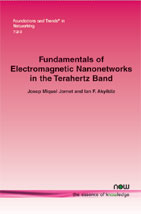Fundamentals of Electromagnetic Nanonetworks in the Terahertz Band
By Josep Miquel Jornet, University at Buffalo, USA, jmjornet@buffalo.edu | Ian F. Akyildiz, Georgia Institute of Technology, USA, ian@ece.gatech.edu
Abstract
Nanotechnology is providing a new set of tools to the engineering community to design nanoscale components with unprecedented functionalities. The integration of several nano-components into a single entity will enable the development of advanced nanomachines. Nanonetworks, i.e., networks of nanomachines, will enable a plethora of applications in the biomedical, environmental, industrial and military fields. To date, it is still not clear how nanomachines will communicate. The miniaturization of a classical antenna to meet the size requirements of nanomachines would impose the use of very high radiation frequencies, which would compromise the feasibility of electromagnetic nanonetworks. Therefore, a new wireless technology is needed to enable this paradigm. The objective of this work is to establish the foundations of graphene–enabled electromagnetic communication in nanonetworks. First, novel graphene-based plasmonic nano-antennas are proposed, modeled and analyzed. The obtained results point to the Terahertz Band (0.1–10 THz) as the frequency range of operation of novel nano–antennas. For this, the second contribution in this work is the development of a novel channel model for Terahertz Band communication. In addition, the channel capacity of the Terahertz Band is numerically investigated to highlight the potential of this still–unregulated frequency band. Third, new communication mechanisms for electromagnetic nanonetworks are developed. These include a novel modulation based on the transmission of femtosecond-long pulses, new low-weight codes for channel error prevention in nanonetworks, a novel symbol detection scheme at the nano–receiver, a new energy model for self–powered nanomachines with piezoelectric nano–generators, and a new Medium Access Control protocol tailored to the Terahertz Band. Finally, a one–to–one nano-link is emulated to validate the proposed solutions.
Fundamentals of Electromagnetic Nanonetworks in the Terahertz Band
It is widely accepted that nanonetworks will enable a plethora of long–awaited applications, ranging from healthcare to homeland security, industrial development and environmental protection. Enabling communication among nanomachines is still a major challenge. While it is acknowledged that there is still a long way to go before having a fully functional nanomachine, this book makes the case that hardware-oriented research and communication–focused investigations will benefit from being conducted in parallel from an early stage. Fundamentals of Electromagnetic Nanonetworks in the Terahertz Band defines the first steps towards enabling electromagnetic communication among nanomachines in the Terahertz Band (0.1–10 THz). The starting point is the development of novel graphene-based plasmonic nano–antennas, which efficiently operate in the Terahertz Band. The authors have developed a novel Terahertz Band channel model and investigated the potential of this frequency band by means of a channel capacity analysis. In light of the channel peculiarities and the nanomachine capabilities, they put forward a set of communication mechanisms for nanonetworks, which include femtosecond–long pulse–based modulations, low–weight channel coding schemes, a new symbol detection scheme at the receiver, and a new medium access control protocol for nanonetworks. In addition, the book analyzes the performance of perpetual nanonetworks by developing a joint energy harvesting and energy consumption model for self-powered nanomachines. Finally, an emulation platform has been developed to simulate a one–to–one nano–link between nanomachines and validate the developed models.
